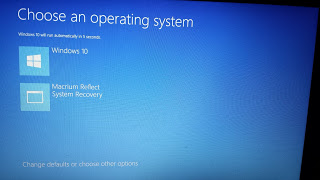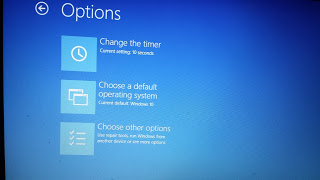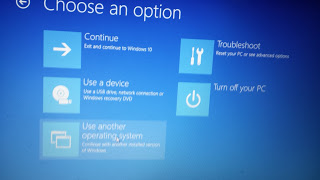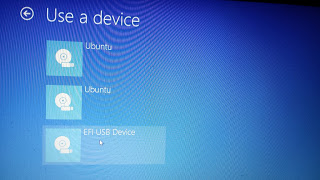Introduction
Updated For Ubuntu 16.04
This tutorial shows you how to create a Ubuntu 16.04 USB drive using Windows 10 (although it will also work for other versions of Ubuntu including Ubuntu 15.10, Ubuntu 15.04 and Ubuntu 14.04).
It is written for Windows users thinking of trying Ubuntu out and is part of a larger guide showing how to dual boot Windows 10 and Ubuntu.
Download Ubuntu
Download Ubuntu from http://www.ubuntu.com/download/desktop.
The latest version of Ubuntu is 16.04 and it is a long term support
release which means it will be supported until 2021.
You do however need to make sure you choose the correct
flavour. The choices are 64-bit or 32-bit.
To find out whether you are running a 32-bit or 64-bit type
“PC Info” into the search box. Click the “About Your PC” option that appears at
the top of the results.
A settings window will appear and halfway down the right
hand side of the page you will see the words 32-bit or 64-bit.
Now that you know whether your computer is running 32-bit or
64-bit you can choose the relevant option on the Ubuntu download page and click
the “Download” link.
You will be asked to make a donation, which helps with the
future development of Ubuntu. The default amount is 15. You can increase or
decrease this amount by either sliding the sliders to the left or right on each
category or entering numbers in the box.
If you want to download Ubuntu for free click the link in
the bottom corner which says “Not now, take me to the download”.
Ubuntu will now start to download.
Download And Install Win32 Disk Imager
Download Win32 Disk Imager from http://sourceforge.net/projects/win32diskimager/
The Win32 Disk Imager software is used to copy a Linux disk
image to a USB drive.
Click the link above and when the above screen appears click
on the green “Download” button.
A file dialog window will appear and you can choose where to
download the Win32 Disk Imager software to.
Click “Save”.
The file will now download. It is around 12 megabytes in
size.
Double click on the downloaded file to start the Win32 Disk
Imager setup wizard.
When the welcome screen appears click “Next”.
A license screen will appear. Click “Next” to continue
(after reading the agreement of course).
You can now choose where you want to install Win32 Disk
Imager. Click “Next” to continue.
The next screen shows which start menu folder the shortcut
for Win32 Disk Imager will be created in. Click “Next” to continue.
If you would like to create a desktop icon leave the
checkbox checked and click “Next” otherwise uncheck the box.
You are finally ready to install Win32 Disk Imager. Click
“Install”.
The files will now be copied and installed to your computer.
Uncheck the box for viewing the readme and launching Win32 Disk Imager. Click
“Finish”.
How To Format A USB Drive
Insert a USB drive into your computer. Make sure it doesn’t
have anything on it that you want to keep because it is about to be wiped
clean.
Open Windows Explorer (Press the Windows key and E key on
your keyboard at the same time). Navigate to the drive letter for your USB
drive, right click and when the menu appears choose “Format”.
Make sure you have chosen the USB drive. The easiest way to check is to
look at the capacity. Your hard drive will be hundreds of gigabytes in size
whereas a USB drive will generally be less than 64 gigabytes and more likely 8
or 16.
If you are happy you have the
right drive selected, check the “Quick Format” option and click “Start”.
How To Create A Ubuntu USB Drive
It is time to create a Ubuntu USB drive and this is the
reason you downloaded and installed the Win32 Disk Imager application.
This application can be used for other Linux distributions
as well as Ubuntu.
In the search box enter “Win32”. An option for Win32 Disk
Imager will appear. Click on this option.
This tool is so simple yet so effective. When the Win32 Disk
Imager window appears click on the folder icon as highlighted in the image
above.
A file navigation window will appear. You need to go and
find the Ubuntu image you downloaded earlier on. (It is likely to be in your
Downloads folder).
When you have found the file click on it and then click on “Open”.
Now all you have to do is click “Write”.
The files will be copied to the disk and you will be able to
use it to boot Ubuntu in a live environment.
Turn Off Fast Boot
You only have to do this on computers with a UEFI bootloader.
In order to speed up the boot time, Windows prevents booting
from a USB until it has fully loaded.
This obviously prevents Ubuntu booting
from the USB drive which is of course a major issue.
You can turn off the fast boot option which resolves the
problem.
Right click on the start menu in the bottom left corner and
when the menu appears click on “Power Options”.
There are lots of power options within Windows 10.
The left hand side of the screen has a list of categories.
Click on the option “Choose what the power button does” as shown in the image
above.
Click the link which says "Change settings that are currently unavailable".
Scroll down the page until you see the option “Turn on fast start-up (recommended)” and turn it off
by unchecking the box.
Click “Save Changes”.
Now you might be wondering why I am recommending turning off a recommended option.As previously mentioned you can’t boot from a USB drive whilst this option is checked. In addition to this I feel that the option is a bit cloak and dagger. What it says is that if you have the option checked your computer will load faster.
The trouble is that once your computer has finished booting it will still go and do all of the things that it missed out on whilst booting to make it load faster but it will do it quietly in the background. This will use up resources until it has completed. In reality your start screen might appear more quickly but it hasn’t really booted and quicker.
How To Boot Into Live Ubuntu USB Environment (non-UEFI)
Make sure that the Ubuntu USB drive that your created
previously is plugged into the computer.
If your computer has a standard BIOS simply reboot your computer and a menu should appear with an option to try Ubuntu.
A large dialogue window will appear with options to install Ubuntu and to Try Ubuntu. Click on the “Try Ubuntu” option.
Ubuntu will now be loaded as a live session. You can try out all of the features of Ubuntu but if you reboot all the changes will be lost.
How To Boot Into Live Ubuntu USB Environment (UEFI)
If your computer has EFI then read on.
If you read the guide showing how to create a Macrium boot menu option then simply reboot your computer and the following screen will appear.
When that screen appears click on the “Change defaults or
choose other options” link at the bottom of the screen.
If you chose not to create the Macrium boot menu option hold
down the shift key and reboot your computer. (Keep the shift key held down
until a screen similar to the one below appears).
Each manufacturer has a different version of UEFI and so the
menu options may be different. The important thing is that a blue screen with
white writing appears.
You are basically looking for the option to boot from the
USB drive and this may take some finding.
From the image above I chose the “Choose other options” menu
item which produced the screen below.
I then clicked on the “Use a device” option which as you can
see has the subtext “Use a USB drive, network connection or Windows recovery
DVD”.
A list of devices will now appear. This isn’t the first time
I have installed things on this computer and my EFI partition still has links to
old Ubuntu versions. The important link on this screen is the “EFI USB Device”
option.
Choose the EFI USB Device option.
An option should appear with an option to try Ubuntu.
Ubuntu should now boot from the USB drive.
An option should appear with an option to try Ubuntu.
Ubuntu should now boot from the USB drive.
A boot menu will appear. Choose the first menu option to try
Ubuntu.
A large dialogue window will appear with options to install Ubuntu
or to Try Ubuntu. Click on the “Try Ubuntu” option.
Ubuntu will now be loaded as a live session. You can try out
all of the features of Ubuntu but if you reboot all the changes will be lost.
Summary
This guide shows you how to create a Ubuntu Linux USB drive using Windows 10.
Hopefully you have found it useful but if you have any comments with regards to the procedure please leave them below as it will help me improve the tutorial for future users.
49 comments
Posted at 00:10 | by
Gary Newell






